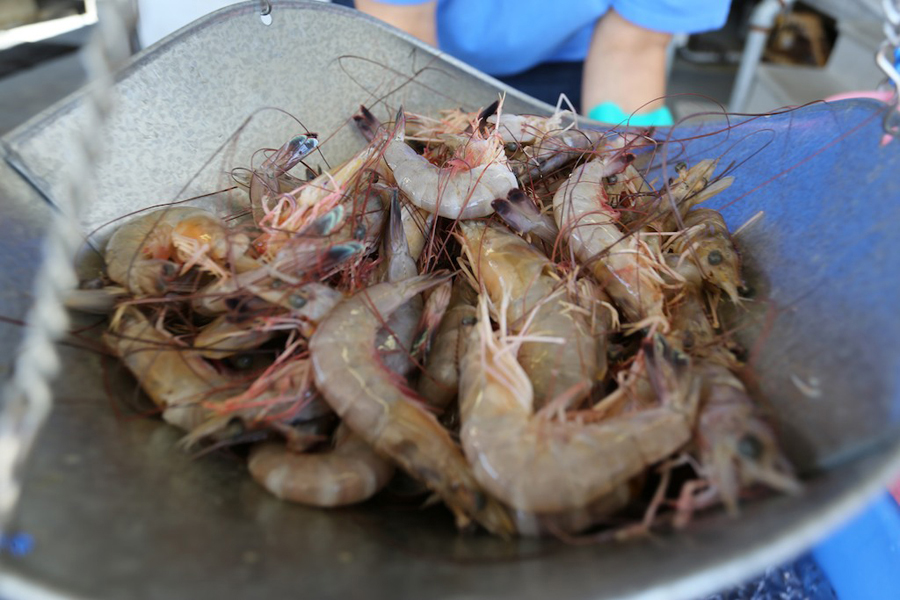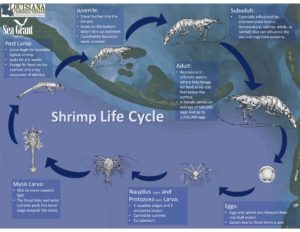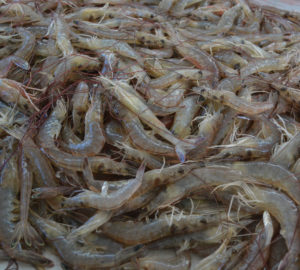Shrimp
Shrimp are found throughout a large range of waters from Nova Scotia south into the Gulf of Mexico as well as the eastern side of Central America. They are important mainly for two reasons, 1) they have good commercial value, and 2) they are an important prey species for many species of finfish. Biologically, shrimp are fast growing and short lived.
The Gulf of Mexico shrimp fishery is one of the nation’s most economically valuable fisheries, and the most valuable fishery in the Gulf. Within the Gulf, historically, Louisiana leads all others in shrimp landings. In 2016, Louisiana landed approximately 102.5 million pounds of shrimp alone (NOAA landings query). Facts aside, 90% of the shrimp that Americans eat is still imported from outside of the United States.

There are only two main penaeid shrimp species found and caught in Louisiana, white and brown shrimp. Seabob and pink shrimp are caught, but in much lower quantities. The brown shrimp are characterized by their brownish appearance and prominent grooves on either side of their head and tail while the white shrimp lack those prominent grooves and are gray in color with very long antennae.
These two species are dominant in the waters at different times. Brown shrimp are found in inshore waters in spring and summer while the white shrimp are predominantly found later in the year, summer through fall.
Shrimp seasons (variable):
- Spring inshore: May to July
- Fall inshore: August to December
- State offshore: (coast to 3 miles offshore) open all year with closures as needed
- Federal offshore: (3-200 miles offshore) open all year
To understand how and why shrimp seasons are set, you must first understand the biology and lifecycle of both brown and white shrimp.
 Shrimp begin life as eggs in offshore waters. As postlarvae, shrimp will move into the shallower estuaries with incoming tides, as they cannot yet swim stronglyon their own. There, in the wetlands created where rivers and bayous meet the Gulf, these young shrimp find lots of vegetation like marsh grass to hide in, and an abundance of food is available.
Shrimp begin life as eggs in offshore waters. As postlarvae, shrimp will move into the shallower estuaries with incoming tides, as they cannot yet swim stronglyon their own. There, in the wetlands created where rivers and bayous meet the Gulf, these young shrimp find lots of vegetation like marsh grass to hide in, and an abundance of food is available.
Both brown and white shrimp share the estuaries to grow, but they occupy them at different times. This sets the stage for the separate spring and fall shrimp seasons.
Brown Shrimp
From February through April, young brown shrimp move inshore—preferring the saltier water west of the Mississippi River. Commercial inshore shrimping is closed at this time to allow these shrimp to grow, and they do so rapidly . . . moving back offshore in late spring/early summer. LDWF biologists monitor brown shrimp closely at this time, and when brown shrimp reach, or are predicted to reach, the size of 100 count per pound, the Department opens the commercial spring season.
White Shrimp
Postlarval white shrimp migrate through passes to inshore estuaries mainly from May through November, with peaks in June and September. So while brown shrimp are moving out in early summer, the young white shrimp are moving in. When LDWF begins to see large numbers of juvenile white shrimp in their test nets, they close the season in mid-June to allow them to grow to marketable size. In late August and September, white shrimp begin to move back out to deeper water in response to cooling temperatures, growing larger. State biologists open the commercial shrimp season back up when the average size of white shrimp reach, or are predicted to reach, 100 count per pound.
This split season ensures that enough mature shrimp survive to reproduce and sustain the fishery. The historical spring and fall seasons are managed by LDWF to correspond with shrimp life cycles, abundance, and size. Louisiana is split into 3 shrimp management zones.
Size
Consumers often find shrimp being sold in many different sizes including small, medium, and large, or by count. To many, these labels can be confusing and hold different meanings. Knowing shrimp size standards will help solve this problem. A shrimp’s size is measured by the number of shrimp it takes to make a pound. For example, if the label reads 16/20, there are between 16 and 20 shrimp in a pound. As you would expect, larger shrimp usually cost more than smaller shrimp and headless shrimp will cost more than head-on shrimp of the same size count. A size guide is provided below. Shrimp count will increase by 2 counts sizes when head is removed and 1 more count size when the shell is removed.
How Much to Buy
When buying head-on shrimp remember that removing the heads will decrease total weight by 35%. When the shell is removed weight decreases by another 15%. For example, 100 pounds of heads-on shrimp will result in 65 pounds of heads-off shrimp. When shells are removed 50 pounds of shrimp flesh is the result.
For boiled shrimp, plan on ½ to 1 pound of shell-on shrimp per person for boiled shrimp. Amount needed depends on whether sides such as corn, potatoes, sausage etc. are being served. Also consider appetite level. Shrimp amounts can be scaled up some for the football team party and down a bit for the ladies’ book club boil.
Transporting Shrimp
Be prepared with proper sized containers and adequate ice when transporting shrimp. Most shrimpers will have ice available to keep your purchase cold, but check in advance to be certain.
Frozen product should not be iced, but placed in an ice chest or insulated container for transportation. Containers should be shaded from direct sunlight and kept as cool as possible. Make sure you have enough container space for shrimp and ice. Longer travel times and warmer temperatures may require more ice.
Remember a full ice chest is quite heavy. Use this handy guide provided for transporting shrimp.
Shrimp is known to be one of Louisiana’s more popular seafood. The best time of year to get shrimp in Louisiana is May through November. A variety of shrimp products can be purchased locally, both fresh and fresh frozen.
Fresh Shrimp
W hole and headless (shell on) fresh shrimp is commonly available from our local shrimp fleet. In addition, many fishermen are offering peeled and peeled-deveined shrimp, which can also be found fresh at local retailers.
hole and headless (shell on) fresh shrimp is commonly available from our local shrimp fleet. In addition, many fishermen are offering peeled and peeled-deveined shrimp, which can also be found fresh at local retailers.
Shrimp are highly perishable, so it’s important to be able to pick on the freshest shrimp possible. Shrimp should have a mild sea breeze, ocean smell. Shells should hold tightly to the flesh and legs should be intact. Meat should be firm and translucent. Avoid product with any scent of ammonia. Look for black spots on the head and body, if present, that is a pretty good sign that the shrimp is not at peak freshness. Nothing tastes better than fresh shrimp right off the boat.
Frozen Shrimp
Shrimp tend to be either frozen in large five lb. blocks or IQF (individually quick frozen) in bags. Always check the shrimp you are buying. Is it freezer burnt? Don’t buy it. Try a different bag. Freezer burn typically indicates that the shrimp were partially defrosted and then refrozen or not handled well during the freeze. Is it imported? Check the label carefully, and don’t be mislead by where it was distributed—you must look for the Country of Origin. Download our handy Shrimp Label Fact Sheet to learn how to check.
Shrimp must always be kept under refrigeration until ready to use. When thawing frozen shrimp, simply place into a bowl of cold water. They should be good to go in a few minutes. Well handled, frozen shrimp is an excellent product. They are available year round and can even be better than fresh shrimp.

